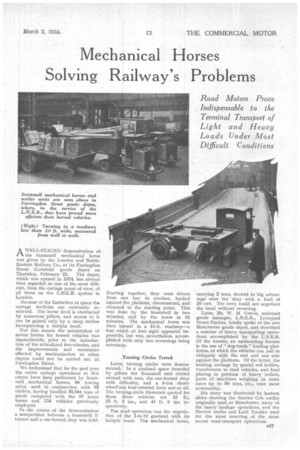Mechanical Horses Solving Railway's Problems
Page 41

If you've noticed an error in this article please click here to report it so we can fix it.
AWELL-STAGED demonstration of the Scammell mechanical horse was given by the London and NorthEastern Railway Co., at its Farringdon Street (London) goods depot on Thursday, February 22. The depot, which was opened in 1874, has always been regarded as one of the most difficult, from the cartage point of view, of all those on the L.N.E.R. system in London.
Because of the limitation in space the cartage facilities are extremely restricted. The lower level is obstructed by numerouspillars, and access to it can be gained only by a steep incline incorporating a hairpin bend.
For this reason the substitution of motor lorries for horsed vehicles was impracticable, prior to the introduction of the articulated five-wheeler, and, the improvements and economies effected by mechanization at other depots could not be carried out at Farringdon Street.
We understand that for the past year the entire cartage Operations at this centre have been performed by Scammell mechanical horses, 60 towing units, used in conjunction with 92 trailers, having handled 85,844 tons of goods compared with the 87 horse teams and 134 vehicles previously employed.
In •the course of the demonstration a zompetition between a Scammell 2tonner and a one-horsed dray was held. Starting together, they were driven from one bay to another, backed against the platform, disconnected, and returned to the starting point. This was done by the Scammell in two minutes, and by the horse in 3i minutes. The mechanical horse was then turned in a 13-ft roadway—a feat which at first sight appeared impossible, but was, nevertheless, accomplished with only two reversings being necessary.
,Turning Circles Tested.
Later, turning circles were demonstrated. In a confined space bounded by pillars the Scammell unit circled around with ease, the one-horsed dray with difficulty, and a 4-ton shortwheelbase four-wheeled lorry not at all. The turning-circle diameters quoted for these three vehicles are 15 ft., 23 ft. 5 ins., and 41 ft. 8 ins. Tespectively.
The next operation was the negotiation of the 1-in-12 gradient with its hairpin bend: The mechanical horse, carrying 2 tons, showed to big advantage over the ' dray with a load of 10 cwt. The lorry could not negotiate the bend without reversing.
Later, Mr. W. M. Gracie, assistant goods manager, L.N.E.R., Liverpool Street Station, briefly spoke of the new Manchester goods depot, and described a number of heavy transporting operations accomplished by the L.N.E.R. Of the former, an outstanding feature is the use of " dog-tooth " loading platforms, at which the vehicles can pull in obliquely with the end and one side against the platform. Of the latter, the loading, carriage by special rail trollies, transference to road vehicles, and final placing in position of heavy boilers, parts of machines weighing in some cases up to 90 tons, etc.; were most noteworthy.
His story was illustrated by lantern slides showing the Karrier Cob outfits originally used, at Manchester, many of the heavy haulage operations, and the Harrow trailer and Latil Traulier used for the most exacting of the more recent road-transport operations.




























































































